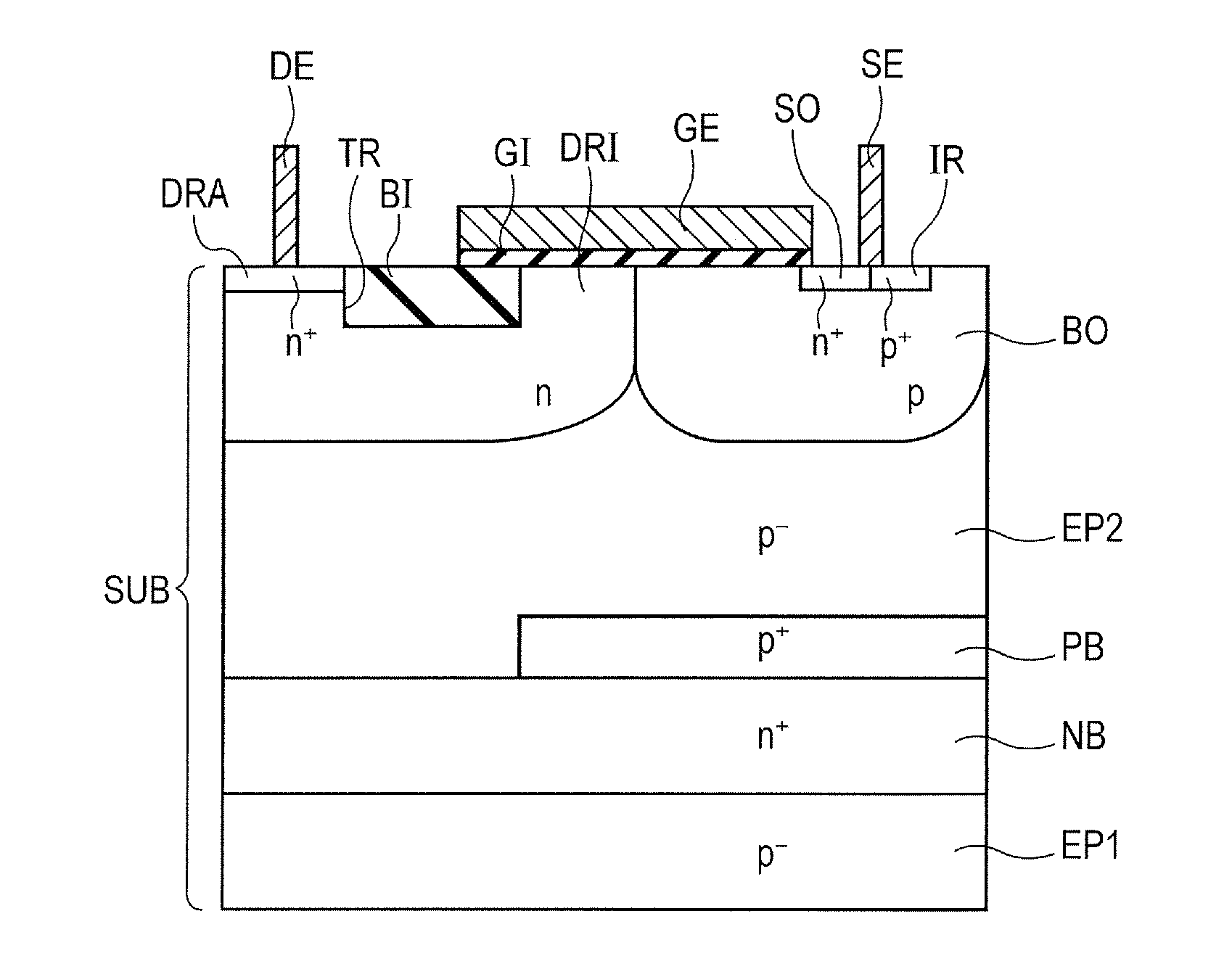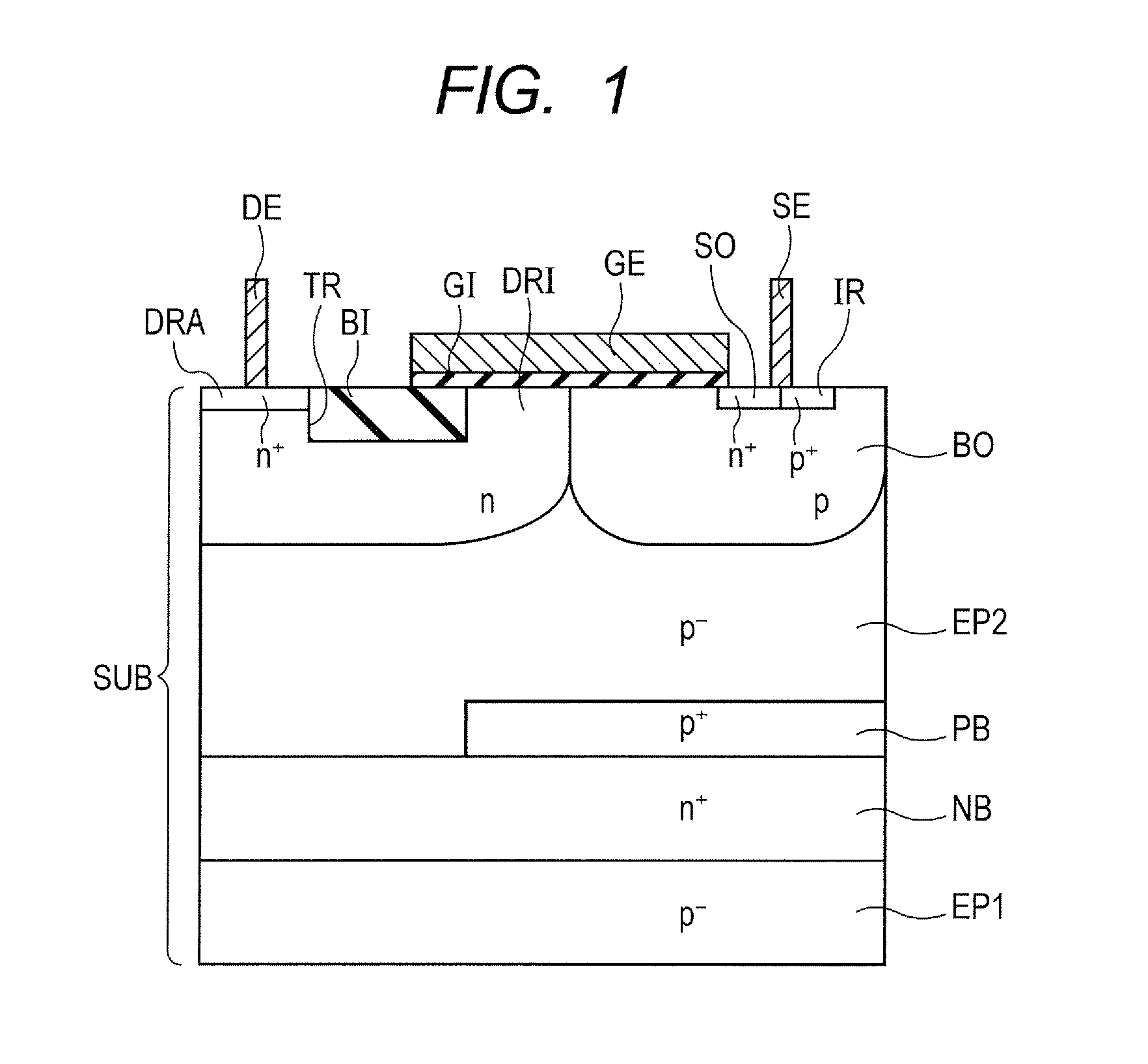Semiconductor device
a technology of semiconductors and devices, applied in the direction of semiconductor devices, electrical equipment, transistors, etc., to achieve the effect of reducing malfunctions
- Summary
- Abstract
- Description
- Claims
- Application Information
AI Technical Summary
Benefits of technology
Problems solved by technology
Method used
Image
Examples
embodiment 1
[0058]Firstly, the configuration of a semiconductor device according to the present embodiment is explained in reference to FIG. 1.
[0059]In reference to FIG. 1, a semiconductor device according to the present embodiment has an LDMOS transistor (lateral insulation gate type field effect transistor) for example. The semiconductor device mostly has a semiconductor substrate SUB, a p− epitaxial region (first region) EP1, an n+ buried region (fifth region) NB, a p+ buried region (sixth region) PB, a p− epitaxial region (second region) EP2, an n-type drift region (third region) DRI, a p-type body region (fourth region) BO, an n+ drain region (drain region) DRA, an n+ source region SO, a gate insulation film GI, a gate electrode layer GE, and an STI structure TR and BI.
[0060]The semiconductor substrate SUB includes silicon for example. The semiconductor substrate SUB has a main surface (a plane on the upper side in the figure). Thep− epitaxial region EP1 is formed in the semiconductor subs...
embodiment 2
[0125]Firstly, the configuration of a semiconductor device according to the present embodiment is explained in reference to FIGS. 30A and 30B.
[0126]In reference to FIG. 30A, a semiconductor device according to the first example of the present embodiment basically has a configuration similar to that of FIG. 1 according to Embodiment 1 but further has an n-type region (seventh region) NR.
[0127]An n-type region NR is formed in a semiconductor substrate SUB so as to reach an n+ buried region NB from the main surface of the semiconductor substrate SUB. The n-type region NR has an n-type diffusion region DNW extending from the main surface side so as to reach the n+ buried region NB and an n-type contact region NCR being formed over the main surface and having an n-type impurity concentration higher than that in the n-type diffusion region DNW. An electrode DE to which a drain potential is applied is formed over the main surface of the semiconductor substrate SUB so as to be electrically ...
embodiment 3
[0143]In an analog-digital consolidated technology, an LDMOS transistor like Embodiment 1 is sometimes formed over one chip through a process identical to the process of a CMOS (Complementary MOS), a bipolar transistor, a diode, a memory device, etc. When a transistor according to Embodiment 1 is laid out over such a chip, it is necessary to electrically isolate the transistor from other elements. In the present embodiment, a structure for electrical isolation is explained in reference to FIGS. 34 and 35.
[0144]In reference to FIGS. 34 and 35, in the present embodiment, an n-type diffusion region DNW (seventh region) is formed so as to surround the circumference of a region ARA where an array (lateral elements) in which the layout of LDMOS transistors shown in FIGS. 3A and 3B for example is repeated is allocated in a planar view. The n-type diffusion region DNW is formed in a semiconductor substrate SUB so as to reach an n+ buried region NB from the main surface of the semiconductor ...
PUM
 Login to View More
Login to View More Abstract
Description
Claims
Application Information
 Login to View More
Login to View More - R&D
- Intellectual Property
- Life Sciences
- Materials
- Tech Scout
- Unparalleled Data Quality
- Higher Quality Content
- 60% Fewer Hallucinations
Browse by: Latest US Patents, China's latest patents, Technical Efficacy Thesaurus, Application Domain, Technology Topic, Popular Technical Reports.
© 2025 PatSnap. All rights reserved.Legal|Privacy policy|Modern Slavery Act Transparency Statement|Sitemap|About US| Contact US: help@patsnap.com



